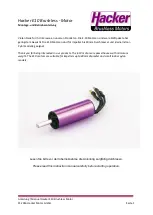
Safety regulations for fluorocarbon
rubber
Fluorocarbon rubber is a common material in sealing
rings for shafts, and in O-rings, for example.
When fluorocarbon rubber is exposed to high tem-
peratures (above 300°C/572°F), hydrofluoric acid
can form. This is highly corrosive. Contact with the
skin can result in severe chemical burns. Splashes in
your eyes can result in chemical wounds. If you
breathe in the fumes, your lungs can be permanently
damaged.
WARNING!
Seals must never be cut with a torch, or be burnt
afterwards in an uncontrolled manner. Risk for
poisonous gases.
WARNING!
Always use chloroprene rubber gloves (gloves for
chemicals handling) and goggles. Handle the
removed seal in the same way as corrosive acid. All
residue, including ash, can be highly corrosive. Never
use compressed air to blow clean.
Put the remains in a plastic container, seal it and
apply a warning label. Wash the gloves under running
water before removing them.
The following seals are most probably made from flu-
orocarbon rubber:
Seal rings for the crankshaft, camshaft, idler shafts.
O-rings, regardless of where they are installed. O-
rings for cylinder liner sealing are almost always
made of fluorocarbon rubber.
Please note that seals which have not been
exposed to high temperature can be handled nor-
mally.
00-0 General
7748841 06-2010
5
Summary of Contents for TAD1343GE
Page 2: ......
Page 4: ......
Page 121: ...P0010531 P0010586 P0010587 21 0 Engine Complete General 7748841 06 2010 117 ...
Page 304: ......
Page 307: ...References to Service Bulletins Group No Date Refers to 303 ...
Page 308: ......
Page 310: ...7748841 English 06 2010 ...










































